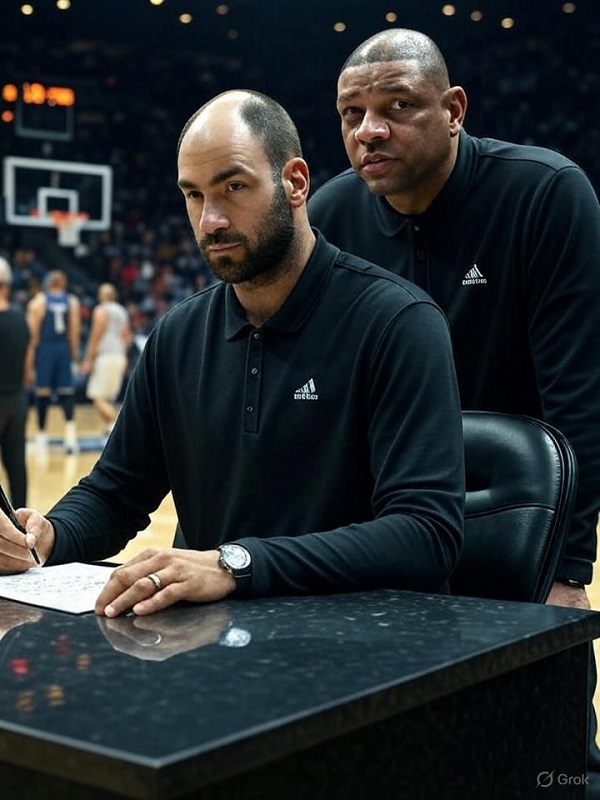The way Greece deploys Giannis differs markedly from his role with the Bucks, highlighting the contrasts between NBA team dynamics and FIBA. Let’s break it down based on his usage, role, and impact. Sure, up to now he has avoided any serious match ups. He knew to sit out the game against Nurkic who probably had his number and has generally played against much easier opponents. But that’s not all.
A More Isolated, Scoring-Heavy Role with Greece
With the Bucks, Giannis operates as the primary offensive engine in a balanced NBA system, but he’s surrounded by complementary pieces like shooters (e.g., Damian Lillard before his departure) and secondary creators who help distribute the load. Milwaukee’s offence often runs through pick-and-rolls, drive-and-kick actions, and staggered minutes with players like Khris Middleton, allowing Giannis to conserve energy for his signature rim attacks while sharing playmaking duties. His usage rate hovers around 35-38% in recent seasons, but it’s mitigated by the team’s depth and the 48-minute NBA game length.
In contrast, Greece under coach Vassilis Spanoulis treats Giannis as an absolute focal point—essentially the “unquestioned alpha” in a roster lacking the Bucks’ spacing and depth. The Greek squad, featuring his brothers Thanasis and Kostas Antetokounmpo, Tyler Dorsey, Kostas Sloukas, and Kostas Papanikolaou, relies heavily on Giannis to carry the load, especially without elite NBA-caliber support like Nick Calathes or Georgios Papagiannis. This has led to more isolation-heavy usage, where he’s often triple-teamed but still explodes for 25+ points in eight straight EuroBasket games—a streak that’s extended to 10 now.
This isolation emphasis stems from FIBA’s tighter court (91 feet vs. NBA’s 94) and distinct rules—no defensive three-second violation, shorter shot clock (24 seconds vs. 30), and more physical play—which amplify Giannis’ drives but expose the team’s limited shooting. Spanoulis has even opted for small-ball lineups, positioning Giannis as the “five” (center) against mixed defences to exploit mismatches. Teammate Tyler Dorsey called him an “unstoppable force,” noting how the team rallies around his dominance despite the roster’s gaps.
Fewer Minutes, But Higher Intensity and Efficiency
One stark difference is minutes played. With the Bucks, Giannis logs 33-35 minutes per game over an 82-game grind, often showing fatigue in clutch moments (as discussed in prior analyses of his high usage). At EuroBasket, he’s averaging under 30 minutes per outing—e.g., 29 in the Israel win—thanks to shorter 40-minute games and blowouts when he’s on. This rest allows fresher legs, leading to absurd efficiency: 78% FG against Israel and 82% vs. Georgia, far surpassing his NBA marks (around 60% FG overall).
However, officiating has been a point of contention. Spanoulis blasted refs after the Spain game, arguing Giannis gets “hacked” without calls—e.g., just 12 free throws despite driving relentlessly—compared to stars like Luka Dončić (20-23 FTs per game). In Milwaukee, Giannis draws 10-12 FTAs per game with NBA whistles favouring stars; in FIBA, the physicality (and perceived bias) forces him to power through without as many trips to the line, making his scoring even more reliant on athleticism.
Rebounding and Defence: Amplified by Necessity
Rebounding is similar (9.8 at EuroBasket vs. 11.9 with Bucks), but Greece’s weaker interior depth means Giannis crashes harder—e.g., 14 vs. Spain and 10 vs. Israel—while also anchoring a switch-heavy defence. With the Bucks, he shares this with bigs like Brook Lopez (pre-trade); here, he’s the lone rim protector, leading to more blocks and steals (e.g., 2 each vs. Georgia). Assists are slightly lower (4 vs. 6.5), as Greece’s offence funnels through his drives rather than complex Bucks sets, though he flashed play making with 9 vs. Spain.
The Bigger Picture: Hero Ball vs. System Ball
Ultimately, Greece uses Giannis as a one-man wrecking crew—isolating him to “play superhero every possession” in a depth-starved setup—yielding MVP-level output but exposing vulnerabilities if he’s off (Greece lost their only game without him, 80-77 to Bosnia). With the Bucks, he’s the hub of a more distributed system, reducing his touches but enhancing team efficiency. This FIBA freedom suits his game on the smaller court, where his length and speed overwhelm, but it risks burnout in knockouts—like tomorrow’s quarterfinal vs. Lithuania.
If Greece advances (they’re three wins from a title, their first since 2005), it could validate this usage as a blueprint for high-stakes play. For Bucks fans, it underscores why Milwaukee needs better support around him heading into 2025-26. Giannis’ EuroBasket run (second-highest scorer at 30 PPG behind Dončić’s 34) proves he’s adaptable, but his true test is blending this dominance with NBA balance.
Unprecedented Usage Rate for a Big Man in the NBA
In the 2023 NBA season, Giannis recorded a usage rate of 38.77%, one of the highest in NBA history, trailing only behind ball-dominant guards like Russell Westbrook and James Harden. Usage rate measures the percentage of a team’s offensive possessions a player uses while on the court, and Giannis’ figure is extraordinary for a power forward/centre. Unlike perimeter ball-handlers who typically dominate usage, big men rarely command such a large share of the offence.
This high usage translates to Giannis controlling the ball for extended periods, often driving to the basket or creating plays. While this maximises his individual impact, it can limit touches and scoring opportunities for teammates. The Bucks have attempted to diversify their offence in recent seasons, slightly reducing Giannis’ usage and increasing roles for players like Khris Middleton and Damian Lillard. Yet, Giannis remains the undisputed focal point of Milwaukee’s attack.
Impact on Teammates’ Offensive Rhythm
Giannis’ ball dominance has a measurable effect on his teammates. Data from sources like StatMuse and NBA.com shows that players like Khris Middleton often perform better in terms of scoring efficiency and usage when Giannis is off the court. For example, Middleton’s effective field goal percentage and per-game scoring tend to rise in minutes without Giannis, suggesting that the latter’s heavy ball-handling can disrupt teammates’ offensive rhythm.
This dynamic is particularly evident in lineups where Giannis’ presence reduces teammates to secondary roles, limiting their ability to find a consistent flow. The Bucks have experimented with staggered lineups to balance this, giving players like Middleton and Lillard more opportunities to handle the ball. However, the team’s heavy reliance on Giannis as the primary creator often overshadows these efforts, especially in crunch time.
Shooting Efficiency: A Growing Concern
While Giannis excels at scoring in the paint, his shooting efficiency from the free-throw line and beyond the arc remains a weak point. His free-throw percentage has declined in recent seasons, dipping below 65% in some years—well below the league average for primary scorers. This inefficiency is particularly costly in high-pressure situations, where missed free throws can shift momentum.
Similarly, Giannis’ three-point shooting is a liability. Over the past few seasons, his three-point percentage has hovered between 22% and 28%, and his attempts have decreased, reflecting either reluctance or a strategic shift away from long-range shots. This lack of outside shooting makes his offensive game predictable, forcing him to rely heavily on drives to the basket. In turn, this can lead to contested shots, increased physical wear, and offensive stagnation against elite defences that clog the paint.
Turnovers, Fatigue, and Clutch Performance
Giannis’ aggressive style contributes to his turnover rate, which averages around 3 per game but can spike in playoff scenarios or under defensive pressure. These turnovers often stem from ambitious passes or drives into crowded lanes, exacerbated by fatigue. Playing 33-35 minutes per game on average, Giannis’ high usage and physical playing style take a toll, particularly in the fourth quarter.
While Giannis scores a significant portion of his points (approximately 29.8%) in the final period, his shooting and free-throw percentages dip slightly in clutch moments. This suggests that fatigue impacts his decision-making and efficiency late in games. Moreover, the Bucks’ defensive lapses during Giannis’ extended ball-handling sequences can leave them vulnerable, as opponents capitalize on transition opportunities or exploit mismatches.
In clutch situations, Giannis’ impact on win probability is mixed. He often generates points through sheer force, but his inefficiencies and turnovers can undermine Milwaukee’s execution when balanced play is critical.
The Bigger Picture: Stats vs. Team Success
Giannis’ individual stats are undeniably impressive—his scoring, rebounding, and playmaking place him among the league’s elite. However, his high usage rate, shooting inefficiencies, and late-game challenges raise questions about whether his style priorities individual production over optimal team outcomes. The data suggests that his ball dominance can suppress teammates’ contributions, while his inefficiencies from the free-throw line and beyond the arc limit his versatility in crucial moments. With Greece this is not the case. Giannis wants to play less so he doesn’t risk injury and Greece wants him off the court at parts of the game when he would be a detriment.
In tougher games, particularly in the playoffs, balanced team play and clutch execution are paramount. Giannis’ current approach, while dominant, may hinder the Bucks’ ability to maximise their championship potential. To address this, Milwaukee could further diversify their offence, encouraging more playmaking from supporting stars like Middleton and Lillard while refining Giannis’ role in late-game scenarios.
So yes, the Bucks could try it but…
Giannis Antetokounmpo’s playing style is a double-edged sword. His historic usage rate and relentless aggression make him a superstar, but they also come at a cost. By limiting teammates’ involvement, struggling with shooting efficiency, and showing vulnerabilities under fatigue, Giannis’ approach can hinder the Bucks in high-stakes games. A more balanced offensive strategy could unlock Milwaukee’s full potential and elevate their chances of winning another championship. But the sad truth is that this sort of approach only works in the Mickey mouse world of the FIBA tournament with second rate players and professionals who do not want to risk injury. Most of them are not playing at full capacity like they would in NBA playoffs where as we have seen many times, Giannis simply cannot move the needle when it counts.

